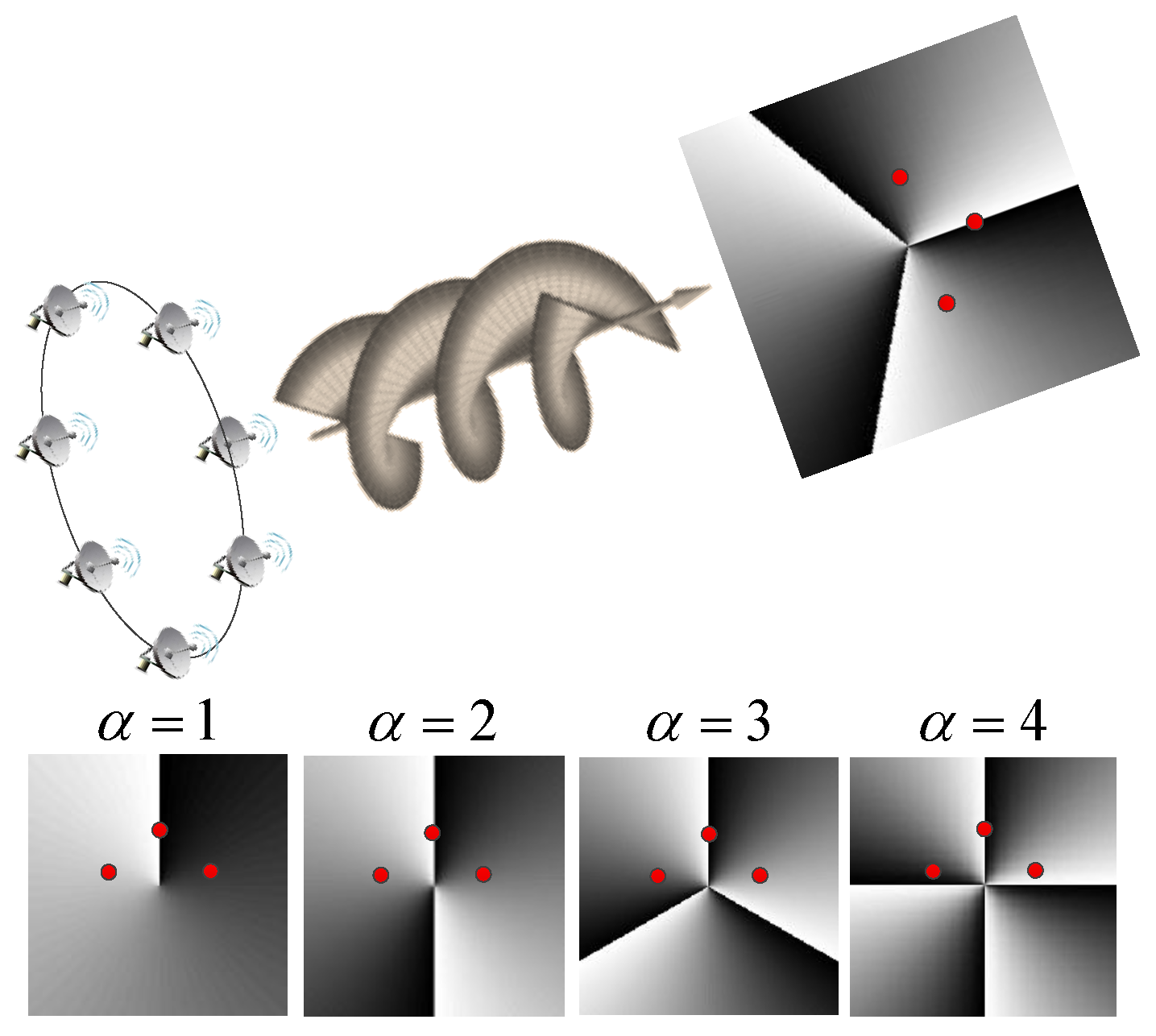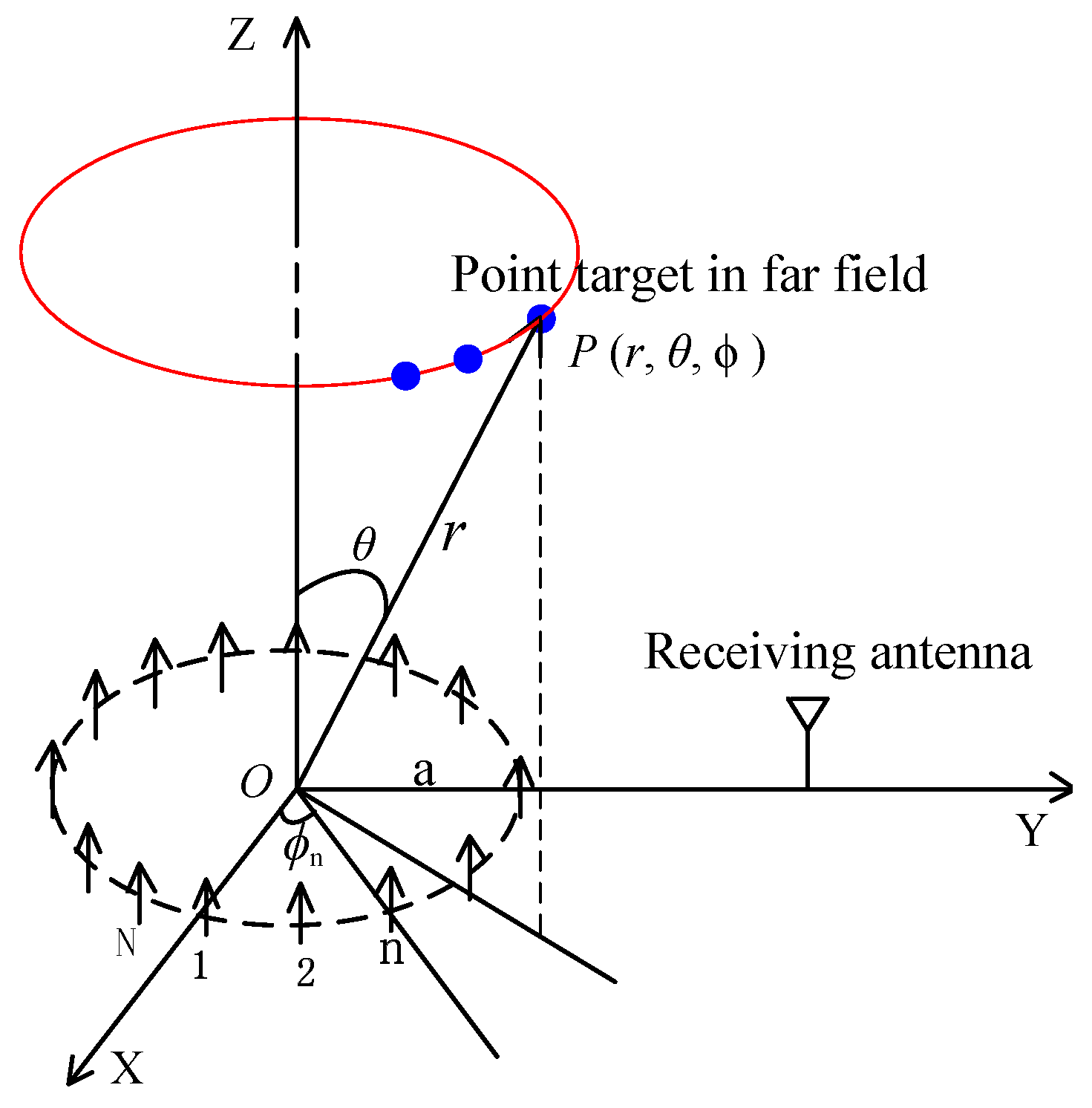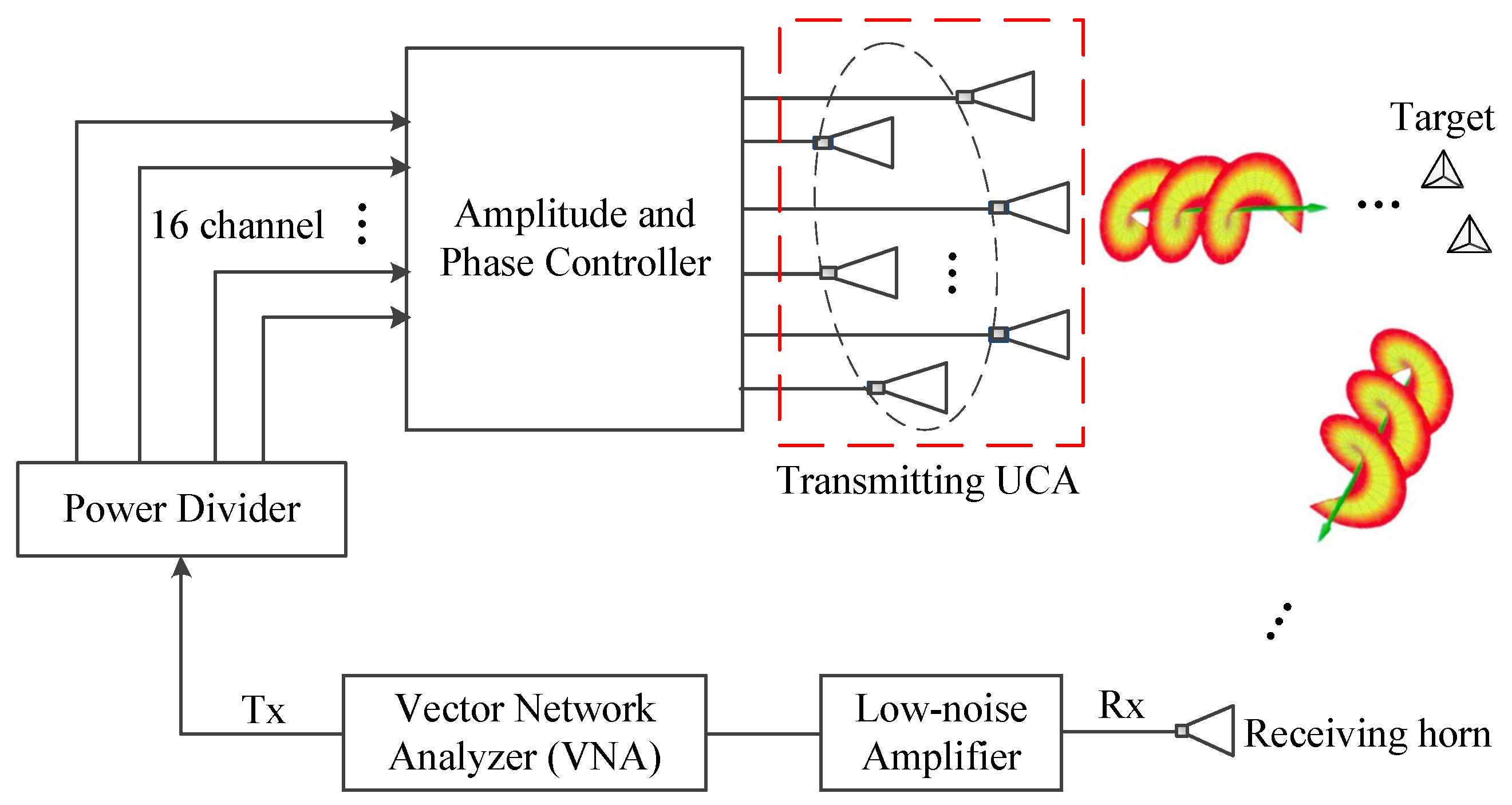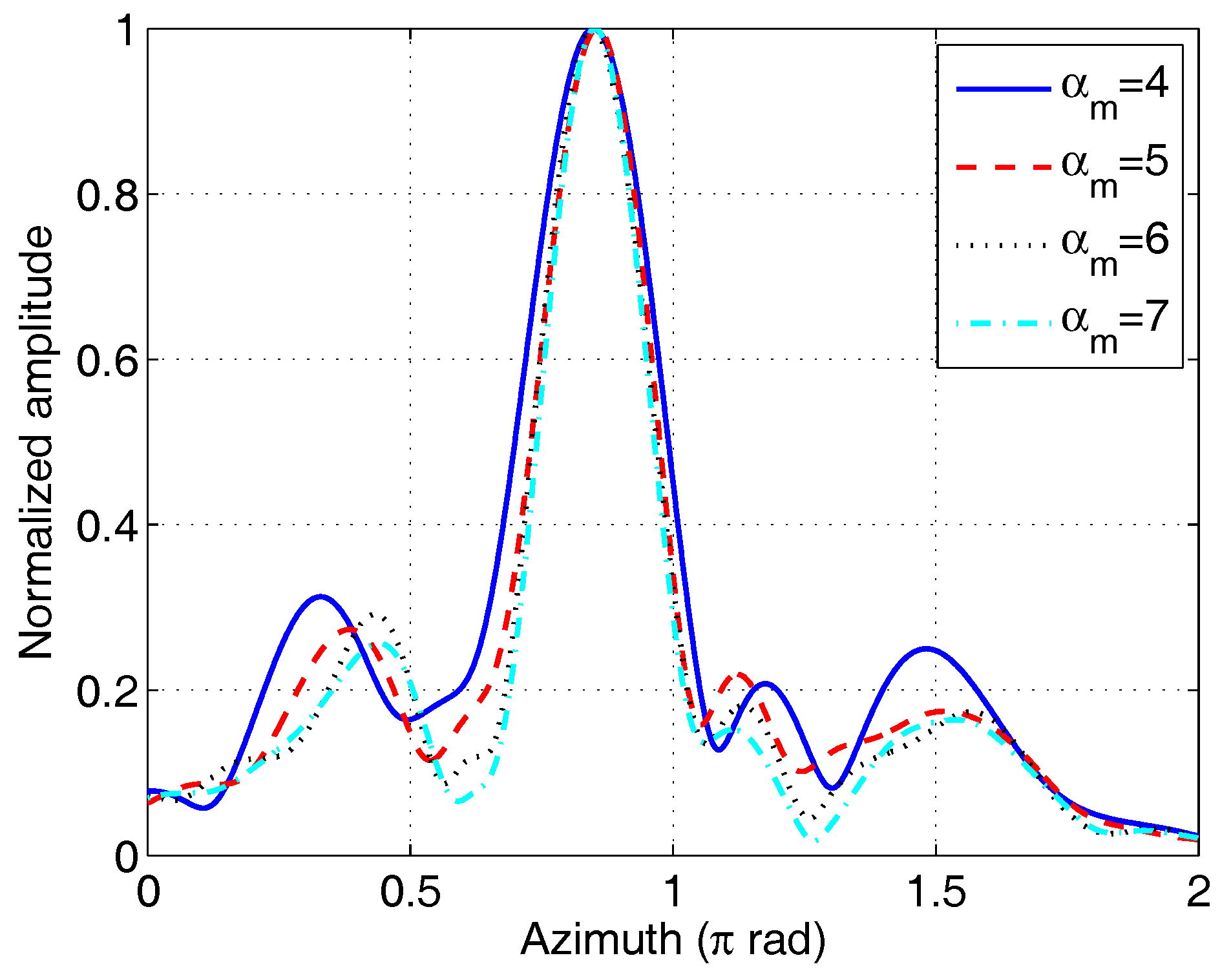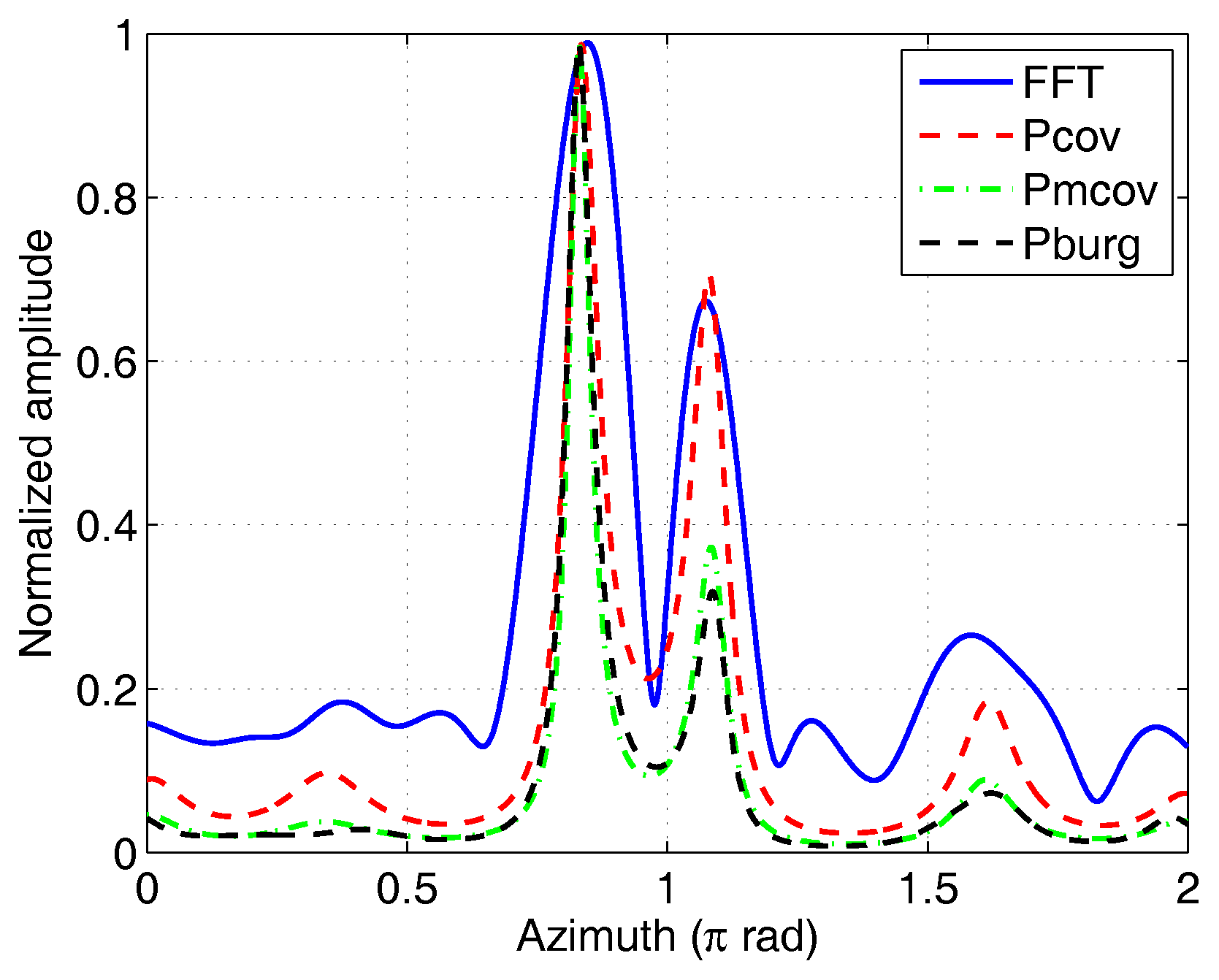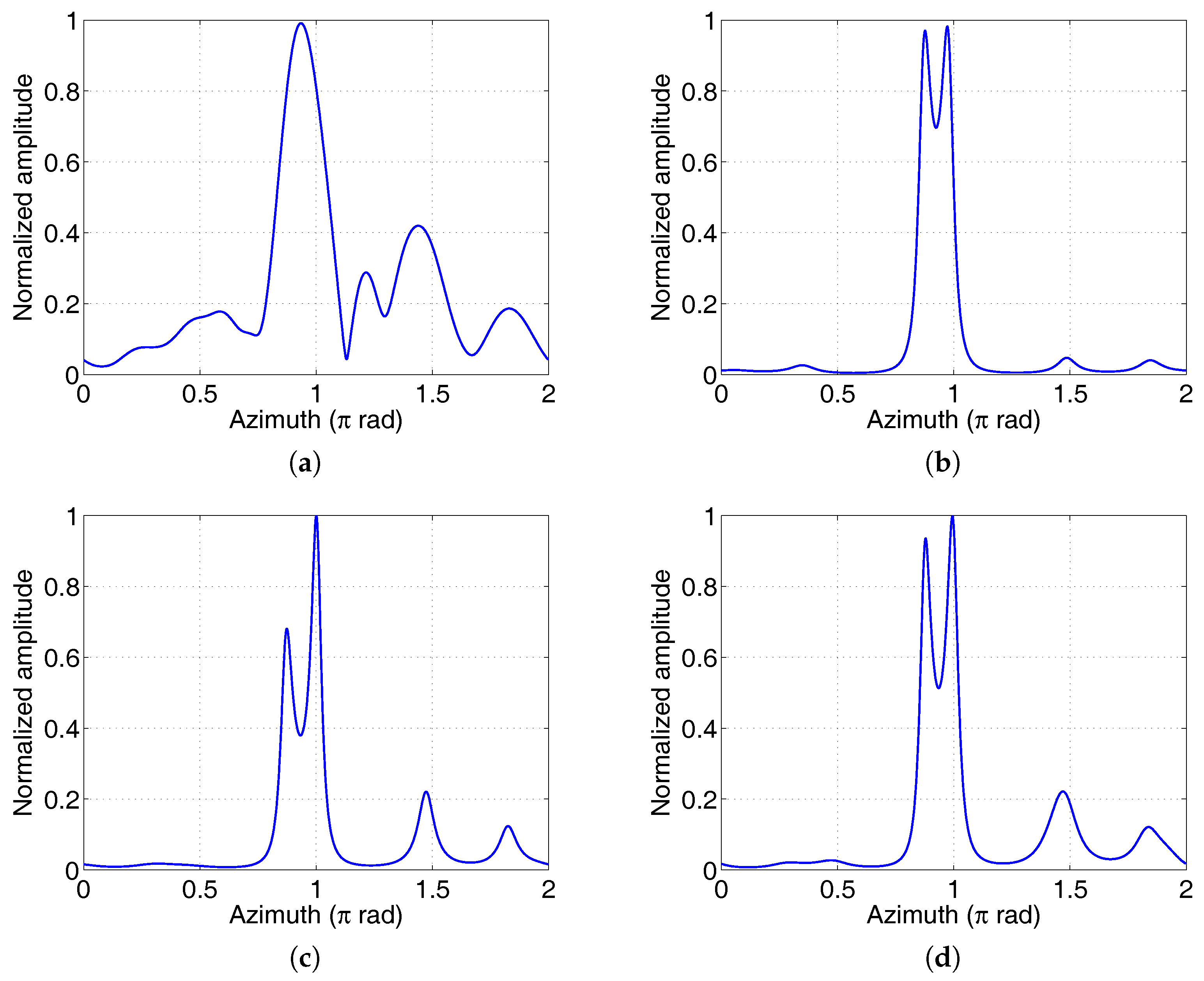1. Introduction
The orbital angular momentum (OAM) of electromagnetic (EM) waves has been attracting increasing attention in optics [
1] and microwave domains [
2,
3,
4] because it provides a new rotational degree of freedom that is distinct from polarization for information transformation [
5]. Hitherto, applications of OAM are mainly concentrated in communications [
6,
7,
8,
9] in both optical and radio frequencies, which makes use of the orthogonality of different OAM modes. Besides, the peculiar wavefront of EM vortices may be useful for sensing target scenes. Recently, the authors presented the application of the azimuth resolution of EM vortices in radar imaging applications, called EM vortex imaging [
10,
11,
12,
13,
14].
Most conventional radar imaging techniques obtain two-dimensional target images via Range-Doppler (RD) principle. High range resolution is obtained by using large bandwidth waveform, whereas the high resolution in cross-range needs large aspect-angle variation. High azimuth resolution is usually obtained by increasing the aperture, as in synthetic aperture radar (SAR). The relative motion in SAR achieves angular diversity. The phase front of an EM vortex is not planar, but rotates around the transmission axis [
15], showing a helical structure in space. The phase of an EM vortex on a constant range varies with azimuth by an integer multiple
α of
, where
α is the OAM mode number. As a result, the phase pattern appears as plane waves illuminating from continuous azimuth simultaneously, achieving angular diversity. As radar coincidence imaging uses the stochastic radiation field [
16], the helical phase front may provide the OAM-carrying EM waves the ability of azimuth resolution without requiring relative motion [
11].
In contrast to the traditional plane wave, the vortical radio wave can provide more information in the cross-range direction. Li et al. [
17] applied vortical radio waves to conventional diffraction tomography, achieving imaging resolution beyond the Rayleigh limit. This super-resolution ability derives from illumination of the target with different OAM modes. The principle of azimuth resolution of EM vortex imaging is illustrated in
Figure 1, showing the phase patterns of four modes on the cross-section perpendicular to the transmission axis. It is known that the phases on the three scatterers are constant when the plane wave is utilized. The phases on these scatterers are different when vortical radio waves are used. Therefore, the adjacent scatterers with different azimuth angles can be resolved using the echoes of the EM vortex. The azimuthal phase dependency actually achieves angular diversity, as that in SAR is achieved through relative motion. The echo of one OAM mode cannot provide enough information for azimuth resolution. Thus, multiple modes are needed to achieve high azimuthal resolution. The more OAM modes the EM fields carry, the better the azimuth resolution that the images can achieve. A uniform circular array (UCA) can produce vortical radio waves with different modes using appropriate phase shift [
5], which has been used for EM vortex imaging but is not the only choice. Range resolution can be achieved by using frequency diversity. When the vortical radio waves with various modes and frequencies are used, the range-azimuth images can be reconstructed from the two-dimensional echoes.
Previous studies mainly used array antennas as receivers, where all the elements receive the echo with the same phase shift as transmitting [
11]. In fact, the echo received by a single antenna can also achieve azimuth resolution. In this paper, we focus on EM vortex imaging with a single antenna as the receiver. We first formulate the imaging model with a single receiver located at an arbitrary position. Compared with the multiple-receivers case, the target images cannot be reconstructed directly by Fourier transform method due to the sign changes in the envelope of the received signal, which leads to a point spread function (PSF) without a peak. We propose a method to remove the sign changes in the echo envelope; that is, compensating a phase for each OAM mode based on the array parameters and the elevation of the target. A proof-of-concept imaging system is created and experiments are performed in an anechoic chamber. The phase compensation method is detailed, and further analysis of the experimental results is done in this paper. The simulation and experimental results validate the imaging principle and the effectiveness of the proposed phase compensation method.
The rest of this paper is organized as follows. In
Section 2, the imaging model and PSF are compared for the single and multiple receiving antennas, and the failure of the basic Fourier method is revealed.
Section 3 details the proposed phase compensation method.
Section 4 introduces the experimental setup and gives the azimuthal image of the corner-reflector target reconstructed by different methods using the experimental data. Finally, we conclude this paper.
2. Imaging Model and Problem Statement
The considered EM vortex imaging system consists of a vortex beam transmitter and a single receiver. Since it needs multiple OAM modes for azimuthal resolution, a circular phased array antenna is used as the transmitter. It is convenient to generate various modes by feeding with different phase shifts.
The typical imaging geometry is presented in
Figure 2. According to the phase pattern of the vortical radio waves [
15], the phase varies linearly along the azimuthal direction (the red circle in
Figure 2) within the beam. When the target is illuminated by the vortical EM waves, its azimuth information is modulated on the OAM dimension, which can be extracted from the echoes of multiple OAM modes. The imaging model is formulated in the following.
The transmitting UCA in
Figure 2 consists of
N omnidirectional antennas placed on the circle with radius
a. Each element is fed a monochromatic signal with wavelength
λ. To generate mode
α, the phase shift corresponding to the
nth element is
. The maximum OAM mode generated by the array follows the Nyquist criterion (i.e.,
, where
is the maximum mode). The receiver can be placed in any position, which will affect the range profile. For the convenience of implementation and to reduce the effect on range profile, it should be located near the transmitter. For an arbitrary point P
in the far field, the normalized electric field can be given by [
11]:
where
and
is the Bessel function of the first kind of order
α.
and
are the position vectors of point P and the
nth element, respectively.
Assume the extended target consists of
M ideal scatterers with backscattering coefficient
, whose positions are denoted by
. When the multiple frequencies and OAM modes are employed, the echoes received by the single antenna read
where
is the distance from the
mth scatterer to the receiver.
When all the elements are used to receive the echoes, the phase shift
is applied to the
nth element, and then all the echoes are summed coherently. The target echo reads
Seen from the imaging model of Equation (
2), the range and azimuth of the target are associated with the wave number
k and the OAM mode
α, respectively. Note that there is no elevation resolution because the elevation of the target appears in the envelope of the echoes, which has no effect on the phase. Clearly, the two-dimensional Fourier transform method may be used to reconstruct the range-angle image. However, the amplitude modulation of the Bessel function must be considered, which will affect the azimuth profile.
The azimuth profiles of the PSF of the Fourier transform operator in the two receiving cases are given by
where
is the maximum OAM mode used for imaging.
When
, the Bessel function can be approximated as
Based on the FFT property, the PSF in Equations (4) and (5) will possess a pair of symmetric peaks. The Hilbert transform can be used to eliminate the effect of imaging ambiguity [
11]. Subsequently, the range-angle images can be directly reconstructed by Fourier method. However, the condition of
means that the target is far from the beam axis, which is inapplicable in practice for two reasons. Firstly, according to the radiation patterns of the vortical radio waves, the target will be far from the main-lobe region [
15], where the radiation energy is limited and the transmitting power is wasteful. Secondly, there exists mixed mode in the large-elevation region, which will produce ambiguity in the azimuth profile. The way to reduce the ambiguity may spend many antenna elements.
Therefore, a small elevation angle should be chosen in practice, and the approximation of Equation (
6) cannot be satisfied. The PSFs of Equation (
4) with two different elevation angles are shown in
Figure 3. Compared with the large-elevation case, the PSF possesses no peak in the case of small elevation angle. As a result, the Fourier method will fail to construct the target image. However, the PSF in the multiple-receivers case will also possess a peak at zero position, shown in
Figure 3c. We focus on the imaging process in the case of small elevation angle when a single receiver is used.
3. Phase Compensation and Image Reconstruction
As seen from Equations (
2) and (
3), the critical difference between the multiple-receiver and the single-receiver cases is that the echo envelope is a Bessel function in the former case and a square Bessel function in the latter. The sign changes in the envelope of the received signal in Equation (
2) lead to a PSF without a peak at zero azimuth, whereas the peak in
Figure 3c is not affected. If the sign changes of the Bessel function are removed, a similar PSF in
Figure 3c can be obtained.
The sign changes mean that the phase is associated with
α through
. When
is satisfied, the envelope can be expressed as
Clearly, the phase can be compensated by multiplying a phase term
Seen from Equation (
8), the phase compensation can be achieved based on the symbol of the Bessel function, which depends on the argument
and OAM mode
α. When the array parameters are determined, the phase changes with the elevation angle of the target.
Table 1 gives an example of the desired phases for the different modes. A phase shift based on the elevation angle should be added to the echo of different modes. After the phase compensation process, the echo amplitude modulation is similar to the square Bessel function, and the PSF will possess a peak at zero point, which is expressed as
Then, the two-dimensional Fourier transform method can be used to reconstruct the target image.
Figure 4 shows the PSF and the simulated imaging result after phase compensation. Clearly, the PSF can provide azimuthal resolution. There are obvious side lobes in both range and azimuth profiles, which can be partly reduced by the windowing technique. Compared with the multiple-receiver case, the azimuthal resolution using a single receiver degenerates, which is
where
is the variation range of the OAM mode. The azimuthal resolution can be improved by using more OAM modes. The range resolution depends on the signal bandwidth.
Seen from Equation (
2), the elevation information of the target is contained in the amplitude so that the elevation difference will not affect the PSF. The problem is that the proposed phase compensation method depends on the target elevation. Since the target may extend in the elevation direction, it is difficult to perform phase compensation for all scatterers at the same time. Simulation analysis indicates that this method can tolerate the phase compensation error of two modes, and the main-lobe width of the PSF will not be affected. For the simulation parameters in
Figure 4b, the tolerable elevation difference is 5
o. This imaging scheme cannot obtain the elevation information of the target. It can be obtained by many mature technologies using the same circular array with OAM mode
. The position of the receiver has an effect on the range profile if it is far away from the transmitting array. Thus, the receiver should be as close to the array as possible. Ideally, the receiver is located on the center of the transmitting array.
